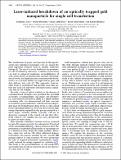Files in this item
Laser-induced breakdown of an optically trapped gold nanoparticle for single cell transfection
Item metadata
| dc.contributor.author | Arita, Yoshihiko | |
| dc.contributor.author | Ploschner, Martin | |
| dc.contributor.author | Antkowiak, Maciej | |
| dc.contributor.author | Gunn-Moore, Frank J | |
| dc.contributor.author | Dholakia, Kishan | |
| dc.date.accessioned | 2014-01-20T17:01:03Z | |
| dc.date.available | 2014-01-20T17:01:03Z | |
| dc.date.issued | 2013-08 | |
| dc.identifier | 63088508 | |
| dc.identifier | ebcab01e-f5bd-43da-aead-4bfd83e77153 | |
| dc.identifier | 84883439161 | |
| dc.identifier.citation | Arita , Y , Ploschner , M , Antkowiak , M , Gunn-Moore , F J & Dholakia , K 2013 , ' Laser-induced breakdown of an optically trapped gold nanoparticle for single cell transfection ' , Optics Letters , vol. 38 , no. 17 , pp. 3402-3405 . https://doi.org/10.1364/OL.38.003402 | en |
| dc.identifier.issn | 0146-9592 | |
| dc.identifier.other | ORCID: /0000-0003-3422-3387/work/34730435 | |
| dc.identifier.uri | https://hdl.handle.net/10023/4407 | |
| dc.description.abstract | The cell selective introduction of therapeutic agents remains a challenging problem. Here we demonstrate spatially controlled cavitation instigated by laser-induced breakdown of an optically trapped single gold nanoparticle of diameter 100 nm. The energy breakdown threshold of the gold nanoparticle with a single nanosecond laser pulse at 532 nm is three orders of magnitude lower than water, which leads to nanocavitation allowing single cell transfection. We quantify the shear stress to cells from the expanding bubble and optimize the pressure to be in the range of 1–10 kPa for transfection. The method shows transfection of plasmid DNA into individual mammalian cells with an efficiency of 75%. | |
| dc.format.extent | 404479 | |
| dc.language.iso | eng | |
| dc.relation.ispartof | Optics Letters | en |
| dc.subject | Therapeutic agents | en |
| dc.subject | Single cell transfection | en |
| dc.subject | Plasmid DNA | en |
| dc.subject | Nanocavitation | en |
| dc.title | Laser-induced breakdown of an optically trapped gold nanoparticle for single cell transfection | en |
| dc.type | Journal article | en |
| dc.contributor.sponsor | EPSRC | en |
| dc.contributor.institution | University of St Andrews. School of Biology | en |
| dc.contributor.institution | University of St Andrews. Institute of Behavioural and Neural Sciences | en |
| dc.contributor.institution | University of St Andrews. Biomedical Sciences Research Complex | en |
| dc.contributor.institution | University of St Andrews. School of Physics and Astronomy | en |
| dc.identifier.doi | 10.1364/OL.38.003402 | |
| dc.description.status | Peer reviewed | en |
| dc.identifier.grantnumber | EP/H045368/1 | en |
This item appears in the following Collection(s)
Items in the St Andrews Research Repository are protected by copyright, with all rights reserved, unless otherwise indicated.

